5 Engagement Metrics That’ll Help Improve Your Search Rankings
We all want to rank higher.
That’s the name of the game. You want to be where users are: search engines. According to Arekestall, “93% of online experiences begin with a search engine. And 70 – 80% of users ignore the paid ads and focus on organic search results.”
If you’ve been penalized by Google, you may be confused about what to do next. You may not even know what got you in trouble in the first place.
More often than most people think, great content alone won’t get you higher rankings.
You also need to keep an eye on the right metrics. Some engagement metrics will help improve your search rankings, and you need to keep an eye on them.
While SEO attracts visitors from search engines, usability is about conversion — helping users meet a goal.
Most people think usability doesn’t matter, as long as your content is well optimized for long-tail keywords. But the reverse is often the case.
Want to improve your search engine rankings? Follow these 5 engagement metrics.
Remember that engagement happens when your customers and users are realizing value from your content.

If you want to improve your search rankings, these 5 engagement metrics are worth measuring:
1. Traffic Correlated to High Rankings
Traffic is the lifeblood of your site.
One powerful way to increase your site traffic is through blogging. HubSpot’s data suggests that the more useful blog posts you publish, the more traffic you’ll generate.

Google makes certain assumptions. For instance, if your site contains useful content, provides answers to users’ questions and is easy to navigate, people ought to visit it. Fair enough, right?
It should be no surprise that Google can use your traffic data to make decisions about your search rankings.
Many SEOs aren’t happy about this, because the majority of them spend more time building links than testing.

About 3 years ago when Google rolled out its Panda update, the focus was to push back against low-quality or thin content.
This means that if you weren’t providing value for your users, your site could have been penalized, and many sites were.
At the same time, there were sites that enjoyed lots of traffic.
Authority sites like CNN and Mashable continue to dominate search results because they generate millions of visitors each month. When you provide value, you’ll find that 8% of your traffic will generate 41% of your revenue.

Traffic is a user-based metric because it’s related to the user’s activities. To further buttress this point, let’s use Moz’s ranking data on over 200,000 domains.
Multiple SimilarWeb data points are included in the data, showing results such as pageviews, bounce rate, traffic, time on site and rankings prinzessin mononoke herunterladen. Moz conducted a study to determine how these user-based metrics correlate with search rankings.
These user-based metrics are interactive, as opposed to static features such as meta description, title tag length, etc.
Dan Petrovic showed how Google can use these interactive metrics to rank web pages as search engines become more sophisticated, while still maintaining their focus on user intent.

Back to the study: Moz examined both direct and organic traffic over a period of 3 months and found that the more traffic a site gets, the higher it tends to rank in Google’s organic results.
Most SEOs and site owners get into trouble when they try to manipulate search rankings. But in reality, SEO – as complicated as it may be – still boils down to one simple thing: provide value.
The graph below illustrates this point: the more value you provide, the more of it you’ll get.

Brands are seeing results, implementing what they learned from SEO 101. They study their audience to know what they want, research profitable and easy-to-rank keyword phrases, then reach out to industry blogs through email outreach.
Ryo Chibo, founder of Tintup.com, increased search traffic by 2600% by sticking to the basics. In January, his splash page traffic was getting 602 monthly visits from search. In March, traffic increased to 15,746 visits.
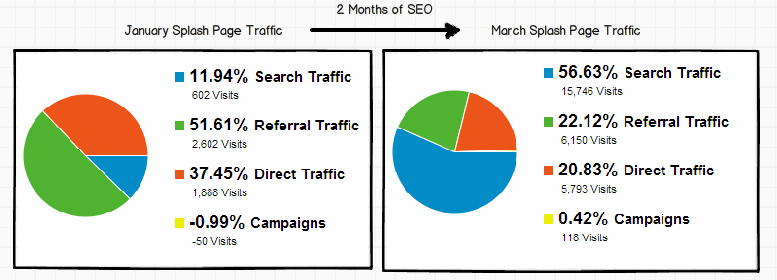
All they did was focus on the SEO basics. They did keyword research, optimized for those keywords naturally and developed a definitive SEO strategy that pulls the right visitors from authority sites to them.
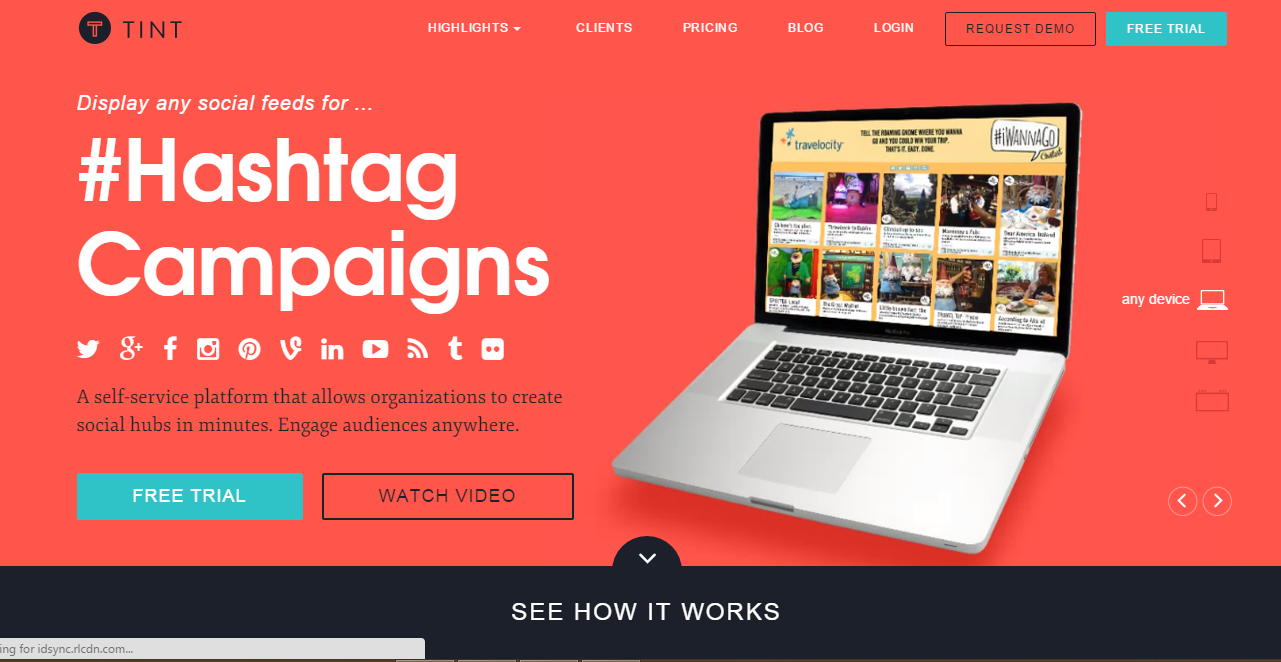
Trying to compete against big brands in the organic listings is a difficult task. You’re not going to see results overnight. Instead, you need to work hard to increase the traffic coming to your site.
Interestingly, you can grow your site traffic through blogging. Both B2B and B2C content marketers use blogging to drive traffic to their sites. In fact, blogging is the #1 traffic-increasing factor, while SEO is #2.
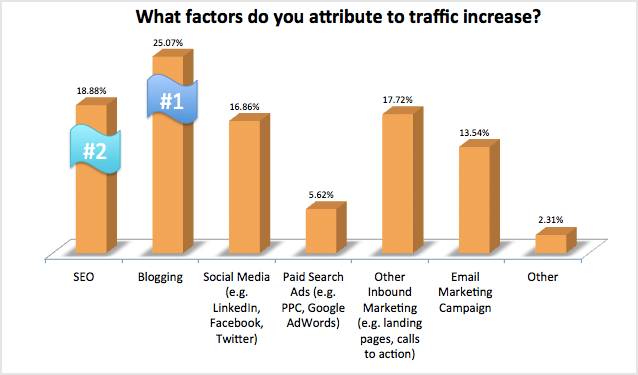
As a blogger, you might see fluctuations in search rankings – that’s normal. But if you’ve built your site correctly and you’ve consistently published helpful and in-depth content, you don’t have to worry.
To an extent, having large traffic numbers is going to result in higher rankings. As your web pages begin to attract unique visitors who care about your content, you can improve some of the metrics that Google uses to calculate rankings:
i). Time on site: Are you able to engage people on your page? This is one of the factors that Google considers before ranking a web page highly or otherwise.
A site that’s difficult to use or to navigate can hurt ranking by reducing time on site, pages viewed and bounce rate. – Brian Dean
Time on site as an algorithmic factor is gleaned from massive user behavior data that Google collects from search users firefox-erweiterung herunterladen. The longer users stay on your site after clicking on your search results, the higher Google assumes the quality of the page is.

Site quality usually depends on several metrics, but time on site correlates to site quality. A higher site quality equals higher rankings and vice versa.
If you can increase the average time on site by engaging visitors and keeping them glued, you’ll increase your site’s quality and rankings.
Depending on your traffic source and the geographic location for most of your traffic, you might want to increase traffic from the U.S., since they have the highest time on site numbers.
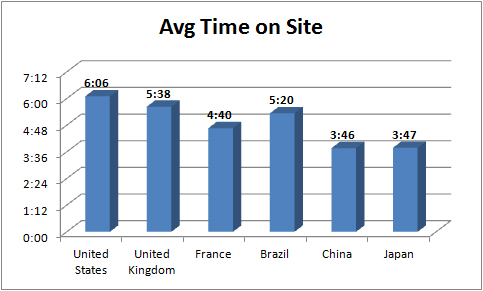
ii). Direct traffic through Chrome: Where your traffic comes from has a strong impact on your search rankings. Direct traffic comes from people who already know and trust your brand.

Google appreciates sites that attract direct traffic, because it shows they’re providing value. Most important, direct visitors spend the most time on sites, by far.
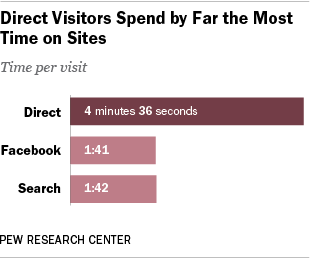
There are lots of browsers out there, but Chrome users can get you preferential treatment (probably because Google owns it).
Growth Traffic theorized that “a high number of repeat users using Google’s browser is a quality signal, and higher quality sites have higher rankings.”
Another article recapping the thoughts of a former Google employee also concluded that Google uses data from Google Chrome to gauge user behavior.
Obviously, sites that generate lots of direct visitors (especially from Chrome) are perceived as higher quality than sites that get very little direct traffic. This can result in a long-term improved SEO performance.

More than likely, increasing direct traffic from Chrome or other browsers boils down to one thing: delivering a great user experience.
If you cater to your users and customers, they’ll refer others to you. This can be the best source of SEO traffic, one that’ll increase your organic rankings month after month.
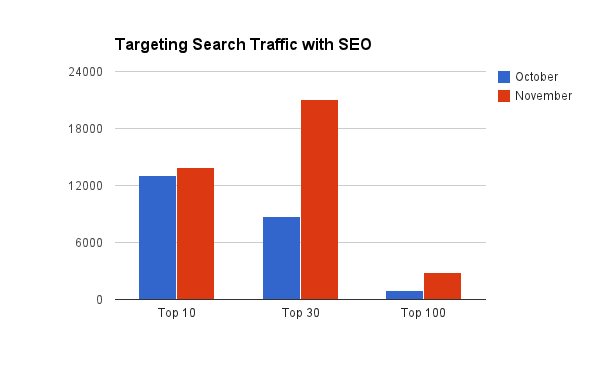
A customer-centric marketing approach yields sustainable organic traffic. In turn, happy customers become brand ambassadors, spreading the good news about your brand and bringing people who’ll linger on your site, increase your time on site metrics and improve your site SEO quality.
A biotech company, New England Biolabs, increased time on site by 74%, decreased bounce rate by 7.5%, and saw a 13% increase in page visits through a marketing approach focused on improving the customer experience.
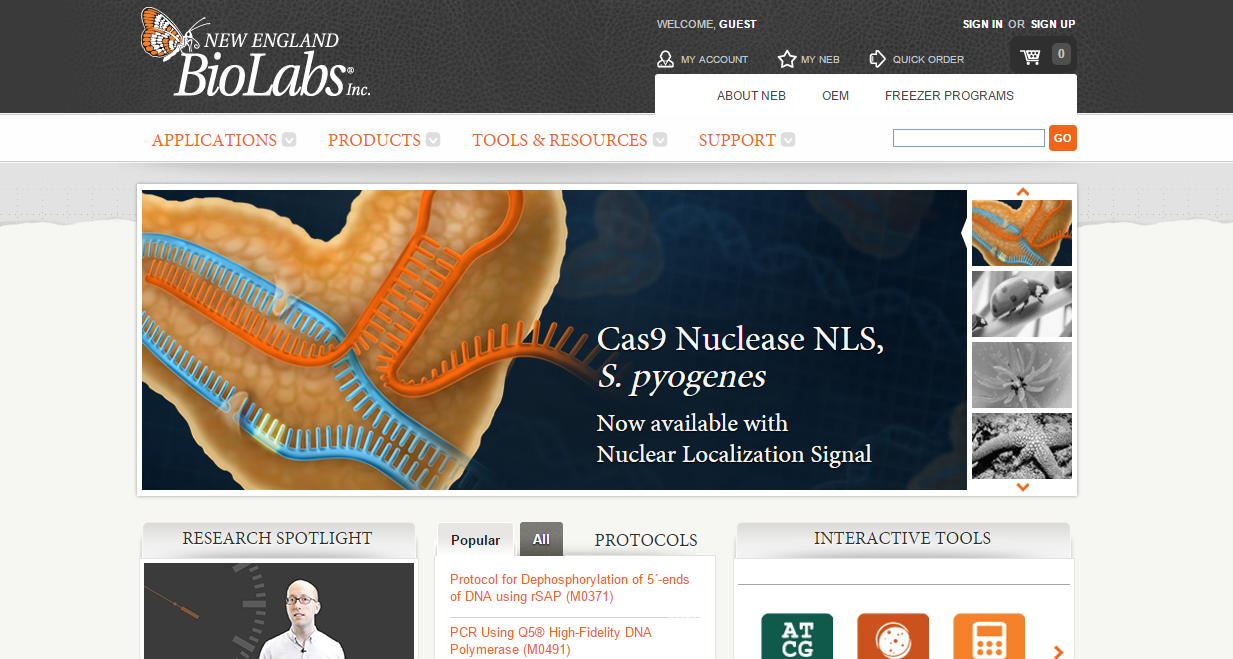
iii). Organic clicks: According to a Chitika study, the number #1 result on a Google first page gets 33% of that search’s traffic windows 10 download laptop. To a large extent, higher search rankings will generate a higher click-through rate & more traffic to your site.

When you start driving visitors to your site, you’ll get more people clicking on your links in the search results. This can reinforce a ranking boost and improve your site quality.
Whether you’re getting the majority of your site visitors from social media, direct sources or paid traffic, these user-based activities will send a signal to Google.
In turn, Google will begin to rank your web pages highly because of the organic clicks they’ve generated from long-tail keywords.

That said, it’s obvious that when you increase your traffic, you’ll likely improve your search rankings.
Again, it won’t happen overnight, but, over time, user activities on your site will impact your search performance in a significant manner.
2. User Engagement Metrics: Bounce Rate & Pageviews
Google follows users. I once listened to Brian Clark deliver a keynote speech where he said that Google is like an infant who needs to be spoon-fed.
As the number of terms people search for increases and more people use Google, the amount of user data Google collects also increases.

Although a lot of changes have taken place in the search algorithm already, Google still relies on their search users to make decisions.
Google uses several user activities to calculate user engagement. We’ve talked about time on site, but bounce rate and pageviews are equally important.
An understanding of bounce rate and time on site will help define your SEO strategy.
What does “bounce rate” mean? Well, let’s allow Google to pull the most relevant definition from its index:
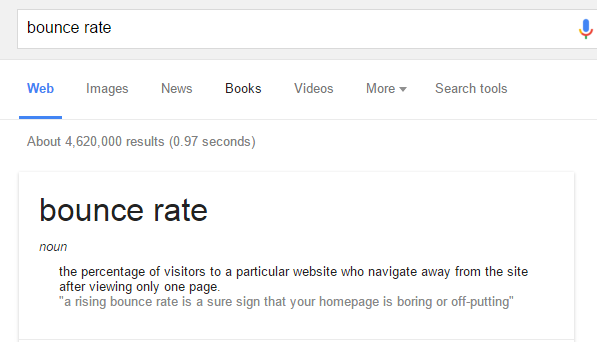
Bounce rate gives us a percentage value, not a ratio or approximate number. Website traffic is calculated in percentages. When people visit your site, both Google and users expect to be treated like a king.
A high bounce rate might be a sign that the landing pages (pages users entered the site from) aren’t relevant to the visitor. The bounce rate formula might interest you:

If they navigate away from the site after viewing a page, it’s likely that page didn’t deliver much value.
Bounce rate is a user engagement metric, because Google monitors how often people visit your site, how long they stay and where they navigate to from the site they landed on.
Here’s a scenario: Whenever I visit Mashable or Moz, I’m always impressed by the usefulness of their content. I’ve never read an article and just left — I’ll always click on a link to learn more or read another article.

That’s what’s expected from your site, too.
If your bounce rate is high, Google may assume that your pages are low-quality. You can log in to your Google Analytics dashboard to check your current bounce rate.

There’s no single standard bounce rate, because different industries cater to different individuals with different types of content.
Technology sites may have a high bounce rate, because the users often only need one piece of information. That might just be the normal user behavior on technology sites herunterladen.
And Google understands, because of the huge amount of data it’s collected from these users over time.

On the other hand, if you run an internet marketing blog, where there’s so much to learn at once (e.g., starting a blog, writing articles, building links, email marketing, networking, etc.), a 70% bounce rate may be too high.
Most SEOs think bounce rate doesn’t matter, but it may be another way that Google uses to measure site quality.
There’s always a reason why people bounced off a page. Maybe it doesn’t provide much value, or maybe it’s difficult to navigate.
It’s your responsibility to figure out what the problem is, so that you can reduce your bounce rate.
Here are the average bounce rates by industry:

Navneet Kaushal noted that,
When you start to see a high bounce rate on your landing pages, perhaps something above your industry standards, it’s a signal that your page and content marketing strategy need some serious attention.
Reducing your bounce rate helps to boost your conversion rate. A proper conversion architecture will give you a clear picture of how to develop a content strategy that will grow your business.

You can lower your bounce rate through responsive design. Robert Greiner decreased bounce rate from 86% to 1.5% in 2 days by implementing responsive layout.
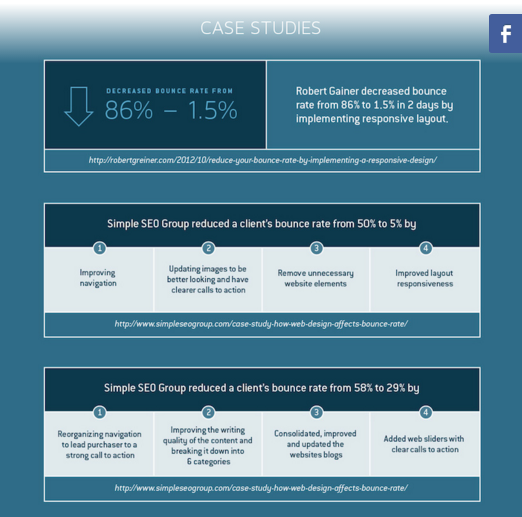
Simple SEO Group reduced a client’s bounce rate from 50% to 5% by:
- Improving navigation
- Updating images to look better
- Writing clearer calls to action
- Removing unnecessary website elements
- Improving responsiveness
I can go on to show you several ways to give you several tips on how to reduce your bounce rate, but I’m sure you already know them.
Do customers enjoy your content? Sure, your post might be useful, but did you format it well?
If you look at a few of my posts, you’ll see how I lay out my posts in an easy-to-read format.

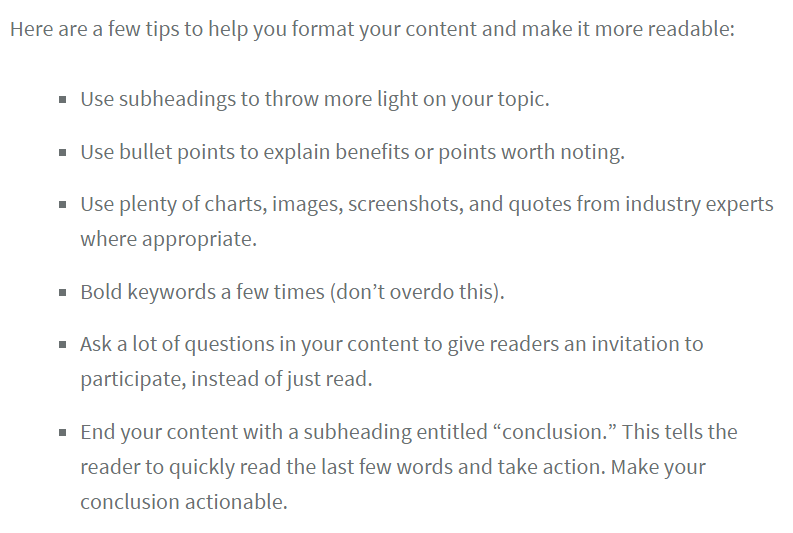
You can test how readable your content is at read-able.com.

What about pageviews?
Page views are another user engagement metric that will help improve your search rankings.
Remember that unique visitors is not the same thing as page views. Page views can change. Here’s a summary of Wikimedia’s page views per project, in 2008.

Here’s Wikimedia’s content page views based on category:

“Impression” is another word for page view. Once a visitor arrives at your page, they’ll read and look at a few more pages, hopefully in order to read more of your insightful content.
Data from Tendenci found that, “on average, a visitor will look at about 2.5 pages. Each page a visitor views (irrespective of the time spent on each individual page) is tracked as a page view.”
Based on a recent survey, it’s estimated that traffic from Bing yields the most page views canva kostenlos downloaden. This study was conducted with the assumption that Google would prove to be the source for most page views.

That’s because search users who come from Google usually come from long-tail keywords — but. as it turns out, that assumption was wrong.
While you should reduce your bounce rate, you should also work to increase page views.
More traffic will result in a higher page view count. Focus on increasing your blog traffic. Stuart J Davidson reached 140,753 page views within exactly 12 months of re-launching his site in November 2013.

Sometimes, you just need to test your campaigns.
As you create content, it’s vital to know what your ideal customers want. Swiss Ringier Group used editorial testing to find their best performing headlines and teaser images.

Testing with Optimizely helped increase click-through rate to articles by 20%. Page impressions also increased by almost 5%. King Rosale, in his comment at Moz, provided some insights on how to increase pageviews. Take a look:
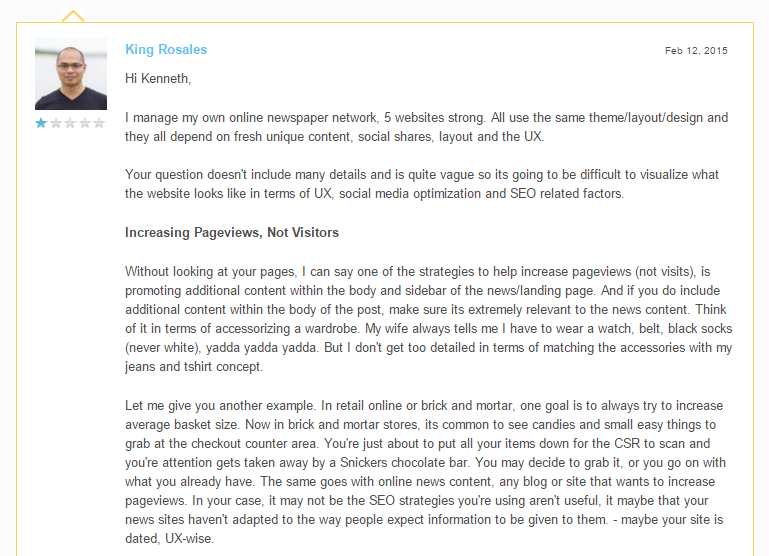
3. Brand Mentions on Authoritative Sites
Are you getting mentioned on trustworthy sites?
It’s a great opportunity to send social signals to Google, which can have a multiplier effect on your search rankings.
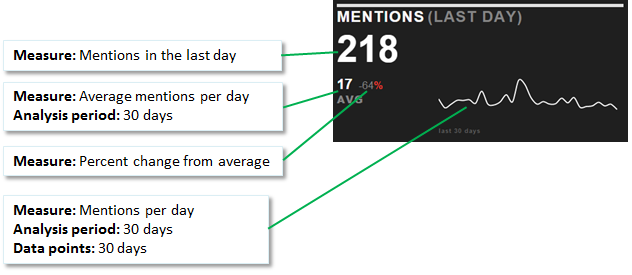
Link building without the links is at the heart of SEO right now. Google tracks brands across diverse platforms.
As a content marketer, you have the opportunity on a platter to promote your brand on social media.
In fact, you can use Facebook, Twitter, LinkedIn, Pinterest, and Google+ to drive engagement, get your content shared and gain traction. Recent data revealed that Twitter drives the most brand mentions across different industries.
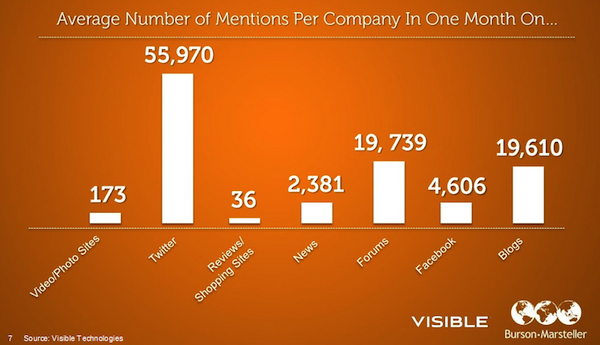
Top brands that get thousands of brand mentions know how to create value for their target audience.
As a blogger, you have to make up your mind to create helpful and interesting posts that your readers can’t find elsewhere.
According to Linqia the reason why 30.7% of men and 44.4% of women follow brands on social media is to keep up with the brand’s latest content.

In today’s business world, the public determines who gets free publicity. In the past, you could directly influence the media to promote you. But, in today’s world, you must create outstanding content.
The whole essence of SEO and digital marketing is to develop and maintain an effective content marketing strategy. Most people think it’s link building, guest blogging social media networking, etc.
All of those activities are essential, but they shouldn’t be the primary focus. When you’ve developed an effective and documented content strategy, you’ll be way ahead of 48% of content marketers who ignores documentation prime video on windows 10.
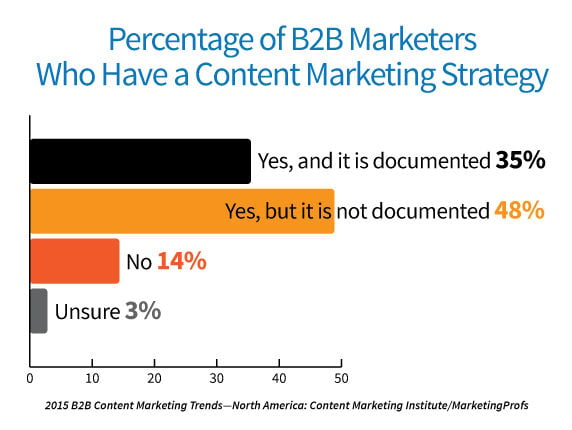
Links still matter in SEO. But the way links affect search rankings now differs. In the past 3 years before the Penguin update, links directly boosted rankings for long-tail keywords. But, in today’s SEO, links improve the authority of a page.
A new patent granted on March 25, 2014, registered to Navneet Panda and Vladimir Ofitserov, establishes the new rules for link building, as explained in the following excerpt:
An express link, e.g., a hyperlink, is a link that is included in a source resource that a user can follow to navigate to a target resource. An implied link is a reference to a target resource, e.g., a citation to the target resource, which is included in a source resource but is not an express link to the target resource. Thus, a resource in the group can be the target of an implied link without a user being able to navigate to the resource by following the implied link.
Every brand and site owner wants to increase their site visibility online. If you want to win the organic visibility war, brand building is the way to go.
Brian Dean listed co-citation, which encompasses brand mentions and brand marketing, as one of the Google’s 200 Ranking Factors.
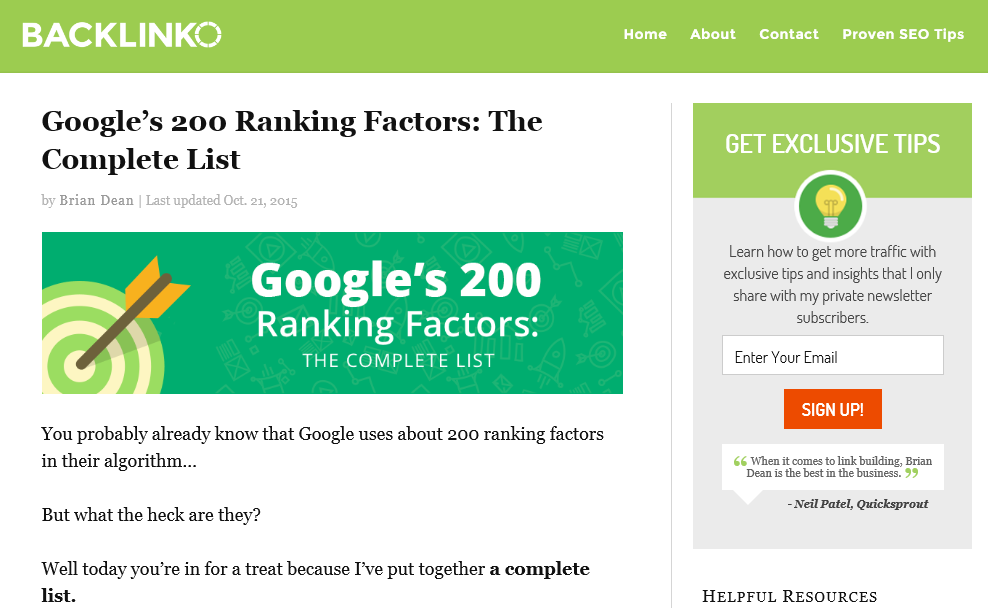
He said that,
When brands get mentioned on authoritative sites without getting linked to, Google likely looks at those non-hyperlinked brand mentions as a brand signal and rewards that site.
In addition to that,
Brand mentions on news sites can have an impact on search rankings. In fact, it can increase the brand’s visibility on Google News portal. That is why some brands have their own Google News feed on the first page:

If you’re reading this, you already know the importance of links in building authority. But, remember that a lot has changed in SEO world over the past few years.
Google has developed systems to measure where your link is coming from, and to gauge where you should rank in the organic results pages.
Brand mentions on authoritative sites can pass a lot of SEO value to your domain name. Your brand may not be hyperlinked, but it doesn’t matter.
It might even be a nofollow link, which we all know won’t pass any SEO value, but Google is starting to consider it as a brand signal. To explain this concept, here’s an excerpt from Simon Penson’s post on Moz:
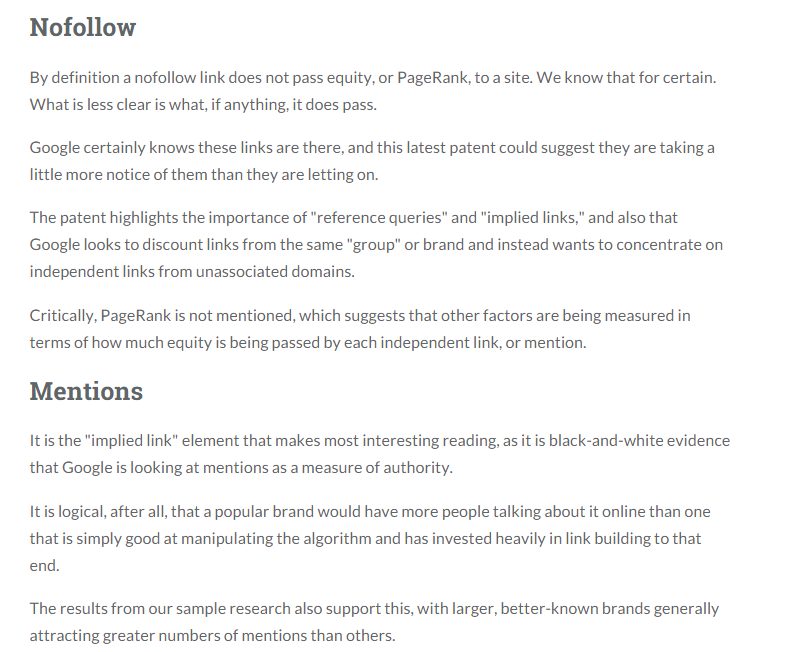
If you want more brand mentions, provide a richer content experience for your customers/blog readers.
Valuable content improves your customer’s experience. When customers are happy, they’ll tell others about your brand.
When you give customers a memorable experience, they are more likely to share it, cite it and refer their friends, family, fans and colleagues to your site.
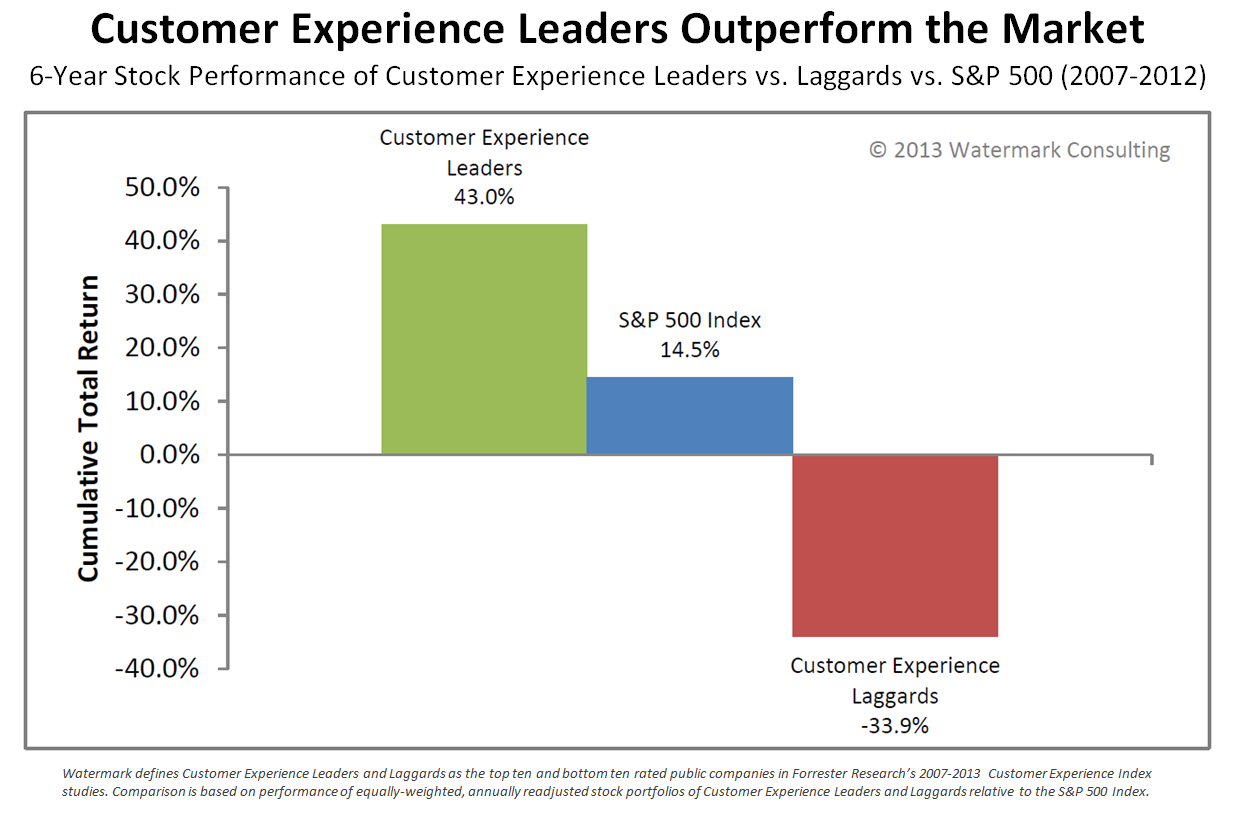
Google collects all this data and uses it to design new algorithmic systems to better serve relevant and informative results to search users.
The moment you start getting your brand mentioned, you can reclaim those implied links that are unlinked at authoritative sites.
You can increase brand mentions through these tactics:

4. Mobile Responsive Web Pages
When mobile friendliness became a ranking factor, 50% of non-mobile friendly URLs dropped in rank.
Change is constant. Different devices and platforms that weren’t even invented ten years ago are now gaining huge market share and use.
Your target audience is counting on you to be where they are wie kann man youtube video herunterladen.
Being able to present your content in a way that automatically and naturally adjusts to however it’s being viewed is critical to your survival and success. It’s true in business, sports, entertainment and yes, web pages.
With a mobile device, your ideal customer is everywhere. Are you making sure your brand is where your customers are?

Mobile marketing is rapidly changing how we communicate with consumers across the internet.
Almost all of your prospects have one type of mobile device or the other. Data from Boostcamp Digital found that “1 in 7 people worldwide use smartphones and 25% of online searches are done on a mobile device.”

Making your web pages (including landing pages and other static pages) responsive, or mobile-friendly, will most definitely increase your search rankings.
Aside from that, mobile users are a targeted set of consumers. As you can see in the infographic above, 70% of mobile searches lead to action on websites within 1 hour.
What is responsive design?
A responsive web page automatically changes to fit the device you’re reading it on, without pinching, scrolling or resizing.

Typically, there have been four general screen sizes that responsive design has been aimed at: the widescreen desktop monitor, the smaller desktop (or laptop), the tablet and the mobile phone.
Mobile marketing is all about developing a mobile content strategy and targeting mobile users who are interested in your offer. And, mobile marketing produces a high ROI.
The screenshot below shows different screen sizes. As the screen gets smaller, the content adjusts and shifts to the best display for each screen.

Consumers desperately want a mobile friendly web page. In the same vein, on April 21, 2015, Google started using mobile friendliness as a ranking factor.
A responsive mobile site will impact your search rankings, traffic and sales. Both B2B and B2C companies are reaping the rewards after redesigning their sites properly for different mobile platforms.
O’Neill collapsed its primary navigation menu, allowing visitors to expand it by tapping a link. The team increased the font size, reduce the number of columns, and fixed Magento forms.
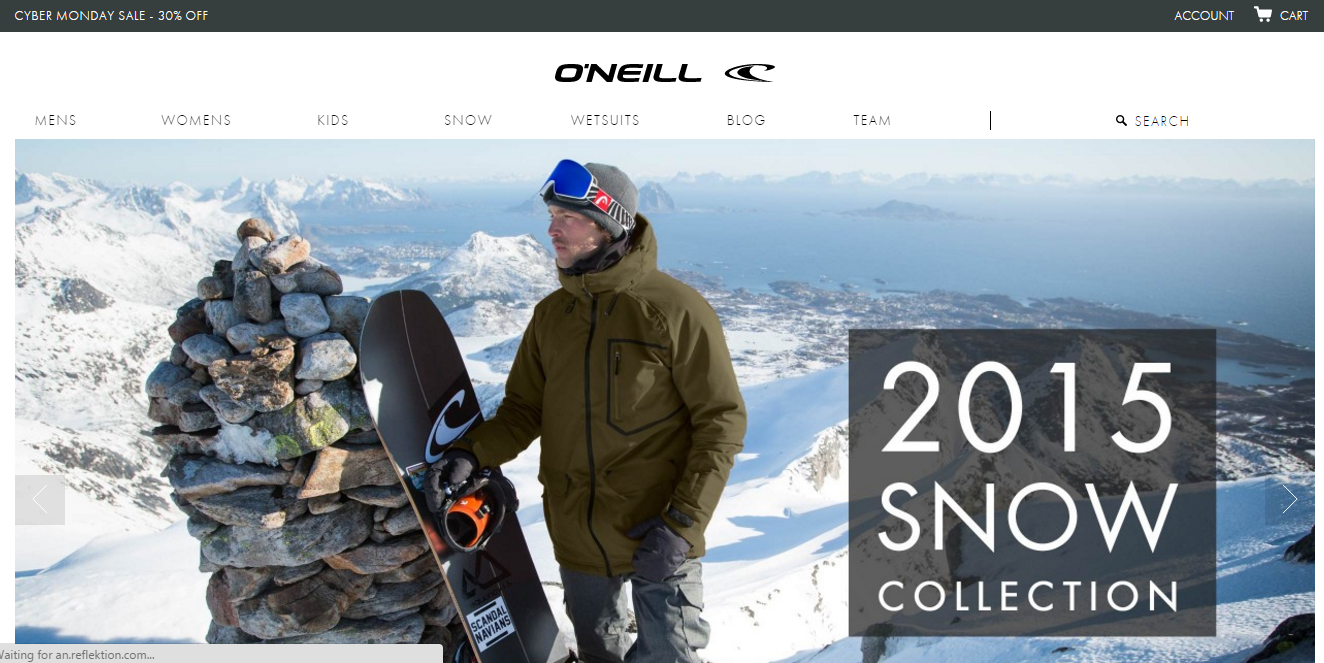
Interestingly, the new changes helped O’Neill achieve some fairly dramatic results on iPhone/iPod:
- Conversions increased by 65.71%
- Transactions went up 112.5%
- Revenue increased by 101.25%
ThinkTank Photo rebuilt its site using a mobile responsive design, as mobile visitors to the site had tripled in a year to 13%.

With the new responsive layout, revenue increased by more than 188% from Black Friday through Cyber Monday compared to 2010, and they saw a 22% increase in mobile page views.
Is your site mobile responsive? Let’s find out:
i). First step: Go to Google Mobile-Friendly Test tool. Input your site URL (e.g. searchenginejournal.com) into the search bar. Then, click the “ANALYZE” button:

ii). Second step: Analyze your site. Allow the tool to analyze your site URL.
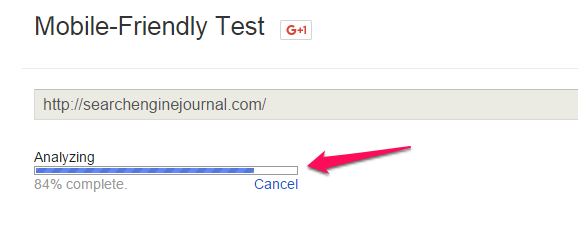
Now, you can see whether your site is mobile friendly or not herunterladen. In this case, searchenginejournal.com is:

Finally, here’s the actual screenshot of how the site displays on mobile device:
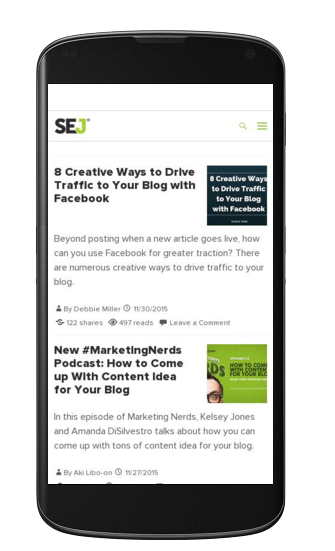
If your web pages aren’t mobile friendly, there are several ways to fix it. The resources below can help:
- How to Make Your Website Mobile Friendly
- How to Make Your Site Mobile Ready
- Build a Responsive, Mobile-friendly Website from Scratch
5. Technical SEO That’s Structured for Users
Technical SEO supports your site, much like the human skeleton supports the rest of the body.
And you’ve got to take it seriously.
Most beginners to blogging use different kinds of WordPress themes without realizing that some of them actually have a negative impact on SEO, through broken tags, hidden CSS and all manner of nefarious codes. That’s why you’ve to be careful where you get your themes, plugins, add-ons, etc.

So how is technical SEO an engagement metric?
Well, it may not be among the engagement metrics that you know very well, but the truth is that the technical aspect of every site is important to Google.
Just as hidden CSS is important to Google, title tags, site load time, mobile responsive web pages, HTML and XML sitemaps, etc., all make up technical SEO as we know it.
But don’t get overwhelmed by the term “technical.” After all, you may not be a web programmer or coder.
It doesn’t matter. Even a newbie can tweak some basic things on the backend of a website to improve its usability.
You create content on your blog and probably guest blog on other blogs. But technical SEO in this case simply refers to any SEO work that is done aside from the content.

This is important, because if you focus only on content, other elements of site usability such as audience, technology, purpose and design will suffer.

Essentially, technical SEO is just laying a strong foundation to give your content the best chance it can have to rank for relevant keywords and phrases.
A few steps you can take to make your site architecture strong and impactful to your overall SEO content strategy are:
i). Create HTML and XML sitemaps: Are you surprised that your content takes 6 to 24 hours, and sometimes more than that, to be indexed?
It happens when your web pages aren’t crawlable. Google’s spider doesn’t discover them, probably because your site is fairly new and doesn’t have many links from authoritative sites and social media networks.
A sitemap is a file that connects all your internal pages, making them crawlable and indexable by a Google spider.

Typically, there are two types of sitemaps you can create: HTML and XML.
HTML sitemaps are primarily designed for users (human beings), but Googlebot and other search engine spiders can easily use them to find your internal pages. The links don’t have to be prominent, because they’re usually linked at the site footer.
On the other hand, an XML sitemap is a text file herunterladen. It has only one URL per link. This is generated for search engine crawlers only, not humans.

One XML sitemap is fine if your site is fairly new or still growing, but if you’ve got a large site with lots of pages, you’ll need more than one XML sitemap.
Remember that a single sitemap can’t be more than 50,000 URLs of 50MB.
Depending on the type of content you publish on your WordPress blog, you’ll need to create separate sitemaps for video, images, articles, podcasts, etc. Make it easy for spiders to quickly and easily crawl your site.
You have a few options to create your sitemap. First, you can use the Bing plugin to generate a server side sitemap.
You can use the Google XML sitemap plugin to generate a crawlable sitemap. Or, use the Yoast All-in-One SEO plugin – it has the option for creating a sitemap for your site.
After creating the XML sitemaps for your blog, you need to submit them in Google Search Console and Bing Webmasters Tools:
In Google Search Console, go to “Crawl > Sitemaps,” and add all of your sitemaps (one at a time), using the “Add/Test Sitemap” button in the top right.

Next, go to Bing, go to the “Sitemaps” navigation panel and enter your sitemap(s):

Caution: Most people forget this part. Don’t forget to add sitemap locations to your robots.txt file.
This tells other search engine bots the exact place to check. In addition to this, if for some reason, you’ve experienced issues with your submission, Google would check there.
Your robots.txt file should include a section like this, with a line for each sitemap:
User-agent: *
Sitemap: http://yourwebsite.com/my-sitemap1.xml
Sitemap: http://website.com/my-sitemap2.xml
ii). Get rid of crawl errors: Another important aspect of technical SEO is getting rid of crawl errors; things that prevent Google from discovering your fresh pages, crawling and serving them to the right users.
You want to optimize your site properly. Just a few steps and your site is ready to be crawled.
Login to your Google Search Console and navigate to “Crawl > Crawl errors”.

You can fix all crawl errors in batches. If you have a large site, you might see a lot of pages that Google spiders have challenges crawling.
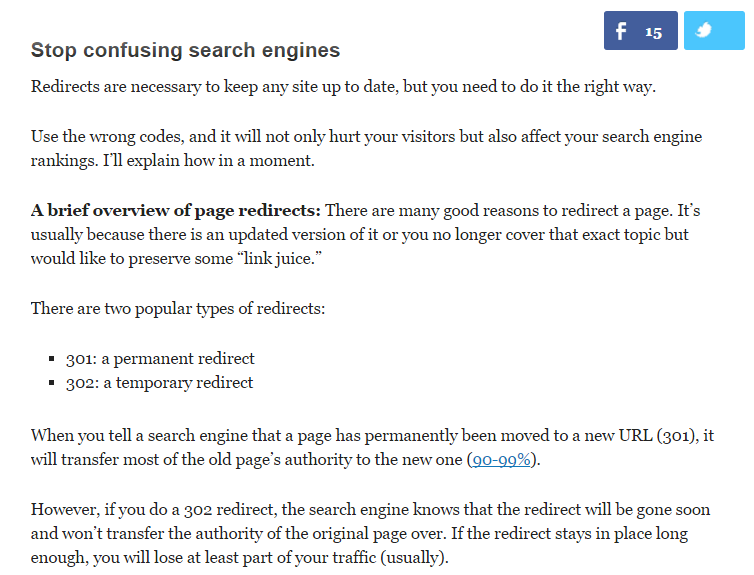
To tackle issues about crawl errors, site architecture and overall technical SEO, you can study the resources below:
Conclusion
You already know things are changing in SEO. Old tactics that worked prior to Google Panda, Penguin and the Hummingbird algorithm updates don’t work now.
The challenge most people have is how they can rank highly in Google without getting penalized.
The truth is, listening to users gives you an upper hand over the competitors that don’t give adequate time to their site users.
As a content marketer and blogger, don’t be like those who wake up, think of a new topic and start banging out a generic article.
I strongly believe in long-form content. In my personal experience, long-form content has contributed immensely to my organic traffic growth, increased search rankings and took my personal brand to a whole new level musik downloaden peggo.
You may never be completely sure about keyword density. But if you can identify questions that your audience is asking, then research data and case studies, you can create high quality content that will get shared, get authority backlinks and be mentioned on authoritative sites.
With consistency, this content strategy alone can grow your search traffic. In all, SEO is a long-term project – for those who are willing to put in the time – to create and promote the best content.
Which other engagement metric do you think has a strong impact in search rankings and organic traffic generation?




Great article and really helpful plus informative content.I was just doing google about it and I just take off in right site thanks for sharing your hard work.